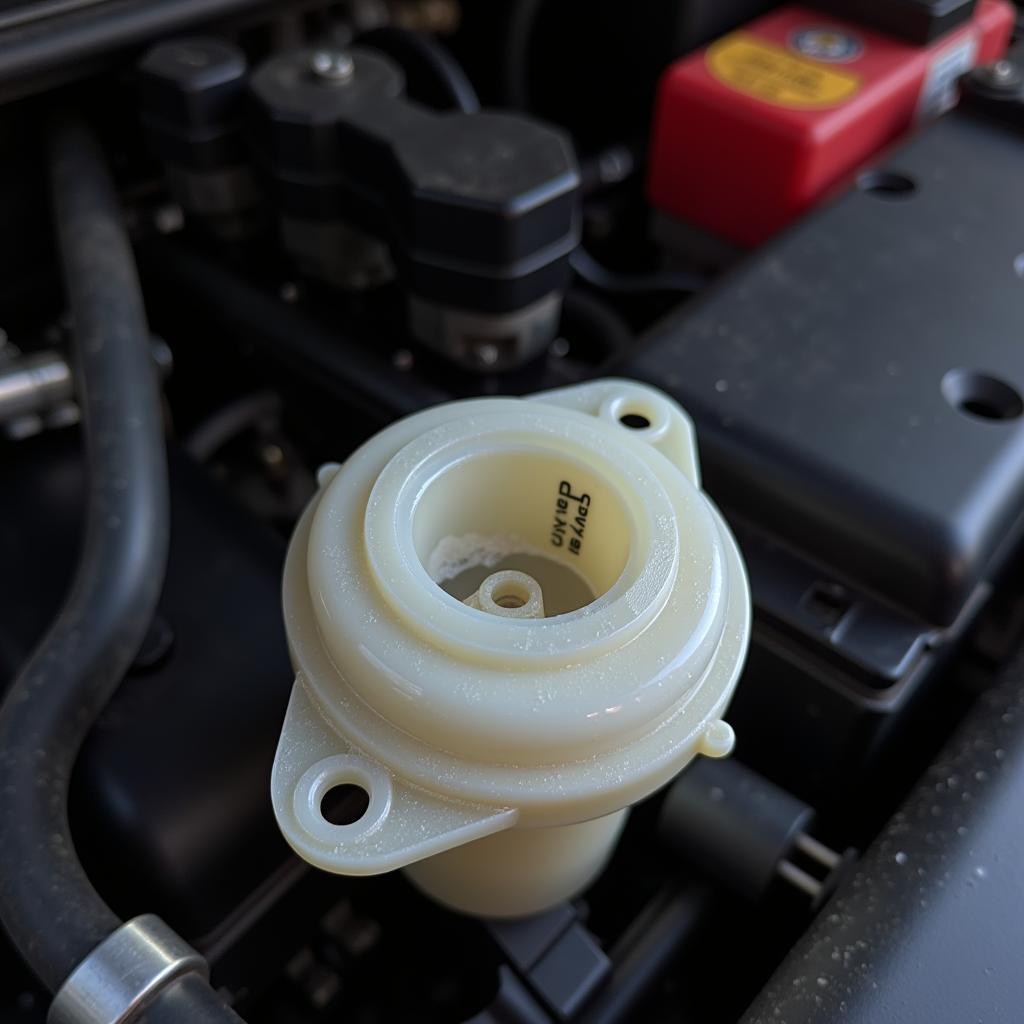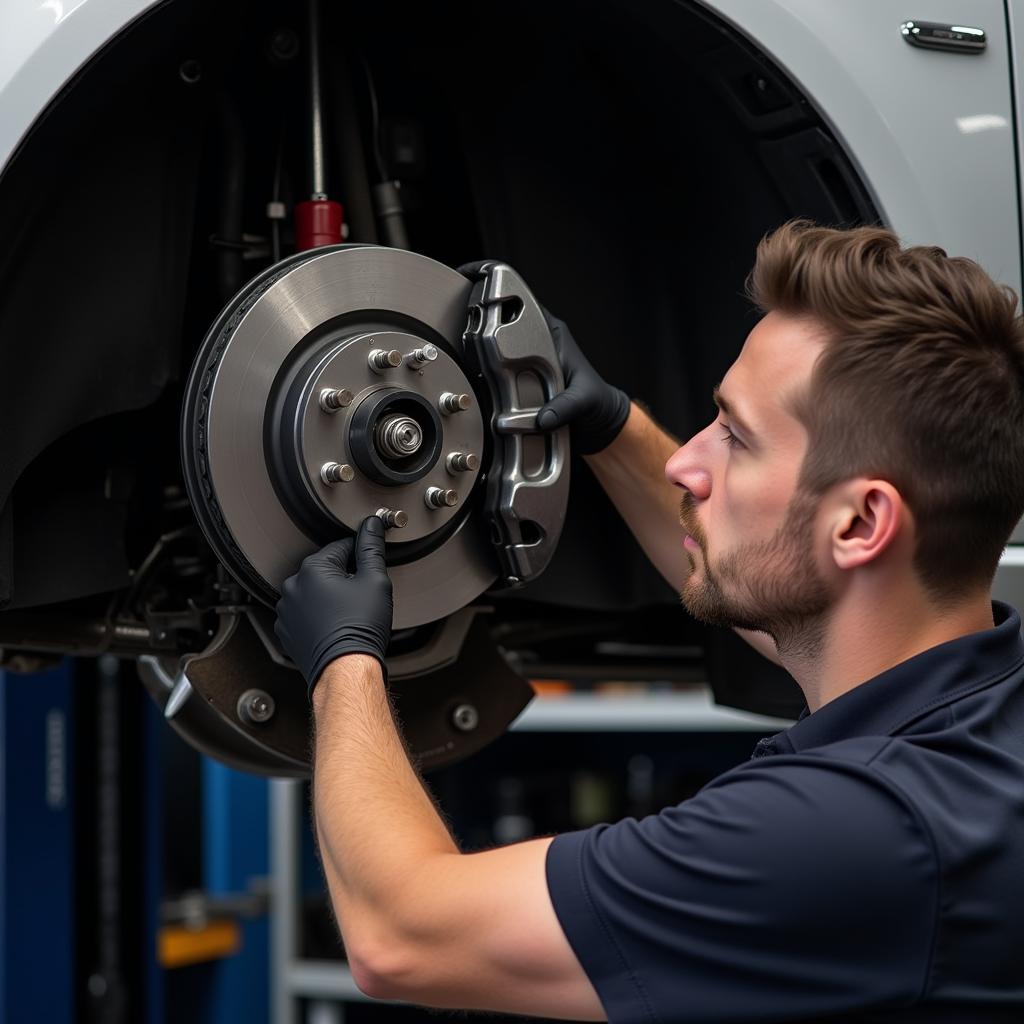Your car’s dashboard is a symphony of lights, but when the brake warning light illuminates, it’s a jarring note that demands attention. This crucial warning signal indicates a potential issue with your braking system that should never be ignored. As an expert in automotive electrical engineering, specializing in remote diagnostics, programming, and software-based solutions, I’m here to guide you through understanding brake warning lights and what steps to take.
Why is My Brake Warning Light On?
There are several reasons why your brake warning light might be on. While some can be simple fixes, others indicate more serious problems requiring professional attention.
Common Causes of Brake Warning Lights:
- Low Brake Fluid: This is one of the most frequent culprits. Brake fluid is the lifeblood of your braking system, and a leak or low level can significantly impact braking performance.
- Parking Brake Engaged: It might seem obvious, but often the simplest answer is the right one. Check if you’ve accidentally left your parking brake partially or fully engaged.
- Worn Brake Pads: Your brake pads are designed to wear down over time. When they reach a certain point, a sensor triggers the warning light to signal it’s time for replacement.
- Faulty ABS System: If your Anti-lock Braking System (ABS) has a malfunction, it can trigger the warning light. This could be due to a faulty sensor, pump, or control module.
- Brake Light Switch Issue: In some cases, a malfunctioning brake light switch can cause the warning light to come on even if your brake system is functioning correctly.
 Brake Fluid Reservoir
Brake Fluid Reservoir
What to Do When Your Brake Warning Light Turns On
If your brake warning light comes on, don’t panic. However, immediate action is essential to ensure your safety and prevent further damage.
- Safely Pull Over: Find a safe location to pull over as soon as possible. Avoid sudden braking.
- Check Your Parking Brake: Make sure it’s fully disengaged. If the light turns off, you’re good to go. If not, proceed to the next step.
- Inspect Brake Fluid Level: Carefully open the brake fluid reservoir (refer to your owner’s manual for location). If the fluid level is low or empty, it indicates a leak requiring immediate professional attention.
- Check Your Brake Lights: If your brake lights aren’t working, it could point to a faulty brake light switch, which is a relatively simple fix.
- Seek Professional Diagnostics: If you’ve ruled out the simpler possibilities and the light remains on, it’s time to consult a qualified mechanic.
 Mechanic Inspecting Brakes
Mechanic Inspecting Brakes
Can I Still Drive With a Brake Warning Light On?
The answer depends on the underlying cause. If it’s simply due to an engaged parking brake or worn brake pads (and you’re sure of this), you can likely drive a short distance to a mechanic.
However, if you suspect a leak, have low brake fluid, or experience changes in brake pedal feel (spongy, sinking, or requiring more pressure), do not drive further. Continuing to drive under these conditions could lead to brake failure, putting you and others at risk.
“Ignoring a brake warning light is like dismissing a flashing red sign at a railroad crossing,” says Mark Williams, a veteran automotive engineer with over 20 years of experience. “It’s simply not worth the gamble. Your safety and the safety of others on the road are at stake.”
Preventing Future Brake Warning Light Issues
Taking preventative measures can save you time, money, and potential headaches down the road:
- Regular Brake Inspections: Have your brakes inspected by a professional at least once a year, or more frequently if you drive in harsh conditions or put significant mileage on your vehicle.
- Timely Brake Pad Replacement: Don’t wait for your brake pads to wear down completely. Follow the manufacturer’s recommended replacement intervals or consult a trusted mechanic.
- Brake Fluid Flush: Brake fluid absorbs moisture over time, which can reduce its effectiveness. Have your brake fluid flushed and replaced every 2-3 years, or as recommended by your vehicle’s manufacturer.
Understanding Your Car’s Braking System
Your braking system is a complex network of components working together to provide safe and effective stopping power.
Key Components:
- Brake Pedal: This is where the driver initiates the braking action.
- Brake Booster: This amplifies the force applied to the brake pedal, making braking easier.
- Master Cylinder: This converts the mechanical force from the brake pedal into hydraulic pressure.
- Brake Lines: These carry the pressurized brake fluid to the wheels.
- Brake Calipers and Pistons: These components squeeze the brake pads against the rotors to create friction and slow the vehicle.
- Brake Pads: These friction materials are pressed against the rotors to generate stopping power.
- Brake Rotors (Discs): These metal discs rotate with the wheels, and the brake pads clamp down on them to slow or stop the vehicle.
Modern Technology and Brake Safety
Advances in automotive technology have led to significant improvements in brake systems, making them more sophisticated and safer than ever before.
- Anti-lock Braking System (ABS): This system prevents wheels from locking up during hard braking, helping the driver maintain steering control.
- Electronic Brake-force Distribution (EBD): This system automatically adjusts the amount of braking force applied to each wheel, optimizing braking performance based on vehicle load and road conditions.
- Brake Assist: This system senses emergency braking situations and automatically applies maximum braking force, even if the driver hasn’t fully depressed the brake pedal.
Conclusion
Your car’s brake warning light is a crucial safety feature that should never be ignored. Understanding the common causes and taking prompt action can help ensure your safety and prevent costly repairs. Regular maintenance and inspections are key to keeping your braking system in optimal condition. If you ever have doubts or concerns about your brakes, consult a qualified mechanic immediately.
FAQs
1. How long can I drive with my brake warning light on?
It depends on the reason. If it’s just an engaged parking brake, you’re fine. However, for other issues, driving is strongly discouraged. If you suspect a leak or experience brake pedal changes, stop immediately and call for assistance.
2. Can I top off my brake fluid myself?
While it’s possible, it’s best to have a professional diagnose the cause of low brake fluid first. They can check for leaks and address the underlying issue.
3. What’s the difference between ABS and regular brakes?
ABS prevents wheel lock-up during hard braking, allowing you to steer and avoid obstacles. Regular brakes lack this feature, potentially leading to skidding and loss of control.
4. How often should I get my brakes checked?
It’s recommended to have your brakes inspected at least once a year or every 12,000-15,000 miles, whichever comes first.
5. Can worn brake pads damage my rotors?
Yes, driving on severely worn brake pads can damage your rotors, leading to costly repairs. Replace brake pads promptly to avoid this issue.
6. Why is my brake warning light flashing?
A flashing brake warning light typically indicates a more serious issue with your ABS system. Seek immediate professional attention.
7. Can extreme temperatures affect my brakes?
Yes, both extremely hot and cold temperatures can impact braking performance and fluid levels. Be mindful of these conditions and have your brakes checked more frequently if you live in areas with extreme climates.
